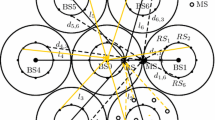Abstract
Relaying technology is one of the LTE-A issue that is considered the area of concern of several researches. Thus LTE-Advanced with relays uses several enhanced techniques in order to improve network performance like cell throughput enhancement and coverage extension. LTE-Advanced is considered as a real evolution of the LTE as it develops new technologies that allow to meet the proposed targets. The Radio Resource Management (RRM) mechanism and relay selection method can greatly contribute to this aim. In this paper, we jointly consider the problem of relay selection and RRM in order to improve the coverage and performance of mobile broadband wireless access service. We give a detailed description of the adopted LTE-Advanced system model with multiple user equipments assisted by one evolved Node B and multiple Relay Nodes. It is important to point out that the microcell technique is jointly adopted in the proposed RRM scheme to provide a better performance. The Microcell technique is considered as a densification approach massively employed in 5G radio access network systems like femtocell and picocell. Call admission control problem is also taken into account mainly when a minimal rate is needed to guarantee user satisfaction. By numerical results, we show that our proposed method could be a better choice for LTE-Advanced standard as it represents a trade-off between the fairness and the user throughput.














Similar content being viewed by others
References
Astely, D., Dahlman, E., Furuskar, A., Jading, Y., Lindstrom, M., & Parkvall, S. (2009). LTE: The evolution of mobile broadband. IEEE Communications Magazine, 47(4), 44–51.
Akyildiz, I. F., Gutierrez-Estevez, D. M., & Reyes, E. C. (2010). The evolution to 4G cellular systems: LTE-advanced. Physics Communications, 3(4), 217–244.
3GPP TR 36.814: Evolved universal terrestrial radio access (E-UTRA)—Further advancements for E-UTRA physical layer aspects (2009).
Nguyen, H. D., Wang, H., & Agoulmine, N. (2010). Sectoring in WiMAX relay to enhance the system throughput. In Proceedings of international conference on BCN.
Kishida, A., Morihiro, Y., Asai, T., & Okumura, Y. (2018). Cell selection scheme for handover reduction based on moving direction and velocity of UEs for 5G multi-layered radio access networks. In Proceedings of international conference on ICOIN.
Maia, A. M., Vieiray, D., de Castro, M. F., & Ghamri-Doudan, Y. (2014). Comparative performance study of LTE uplink schedulers for M2M communication. In Proceedings of international conference of wireless days.
Tamilselvan, R. G., & Prabakar, D. (2013). Cooperative relay based resource allocation for OFDMA network. International Journal of Engineering and Advanced Technology (IJEAT), 3, 2.
Alam, M. S., Mark, J. W., & Shen, X. (2013). Relay selection and resource allocation for multi-user cooperative OFDMA networks. IEEE Transactions on Wireless Communications, 12, 5.
Xie, K., Cao, J. N., & Wen, J. G. (2013). Optimal relay assignment and power allocation for cooperative communications. Journal of Computer Science and Technology, 28(2), 343–356.
Chaudhuri, S., Baig, I., & Das, D. (2015). Utility based QoS aware uplink scheduler scheme for LTE small cell network. In International conference of IEEE mobile and wireless networking symposium conference ICC 2015.
Hsu, L.-H., Chao, H.-L., Liu, C.-L., & Huang, K.-L. (2013). Multi-user MIMO scheduling in LTE-advanced uplink systems. In International symposium on personal, indoor and mobile radio communications.
Safa, H., El-Hajj, W., & Tohme, K. (2013). A QoS-aware uplink scheduling paradigm for LTE networks. In Proceedings of international conference on advanced information networking and applications.
Minelli, M., Ma, M., Coupechoux, M., & Godlewski, P. (2016). Scheduling impact on the performance of relay-enhanced LTE-A networks. IEEE Transactions on Vehicular Technology, 65, 4.
Ma, K., Liu, Z., & Guan, X. (2012). Joint relay selection and power allocation for cooperative cellular networks. Wireless Personal Communications, 24, 2.
Zhao, C., Xiao, L., Kang, S., Chen, G., Li, Y., & Huang, L. (2013). Secure relay selection based on learning with negative externality in wireless networks. EURASIP Journal on Advances in Signal Processing.
Chang, B.-J., & Liou, S.-H. (2017). Adaptive cooperative communication for maximizing reliability and reward in ultra-dense small cells LTE-A toward 5G cellular networking. Computer Networks, 115, 16–28.
Yang, D., Fang, X., & Xue, G. (2011). OPRA: Optimal relay assignment for capacity maximization in cooperative networks. In Proceedings of IEEE international conference on communications (ICC), Japan, pp. 1–6.
Nam, S., Vu, M., & Tarokh, V. (2008). Relay selection methods for wireless cooperative communications. In Proceeings of 42nd annual conference on information sciences and systems (CISS), USA, pp. 859–864.
Saddoud, A., Doghri, W., Charfi, E., & Fourati, L. C. (2020). 5G radio resource management approach for multi-traffic IoT communications. Computer Networks, 166, 106936. https://doi.org/10.1016/j.comnet.2019.106936.
Saddoud, A., Doghri, W., Charfi, E., & Fourati, L. C. (2018). 5G radio resource management approach for internet of things communications. In N. Montavont,, & G. Papadopoulos (Eds.) Ad-hoc, mobile, and wireless networks, ADHOC-NOW, Vol. 11104, Lecture notes in computer science, Springer, Cham.
Saddoud, A., Doghri, W., Charfi, E., & Fourati, L. C. (2019). 5G dynamic borrowing scheduler for IoT communications. In 15th International wireless communications & mobile computing conference (IWCMC), Tangier, Morocco, pp. 1630–1635.
Bouaziz, A., Saddoud, A., & Fourati, L. C. (2018). Dynamic joint resource allocation and femtocell selection for 5G HetNet. In N. Montavont, & G. Papadopoulos (Eds.), Ad-hoc, mobile, and wireless networks, adhoc-NOW, Vol. 11104, Lecture notes in computer science, Springer, Cham.
3GPP TS 36.101 V10.6.0. (2012). Technical specification group radio access network; evolved universal terrestrial radio access (E-UTRA); user equipment (UE) radio transmission and reception, Release 10.
Hcine, M. B. (2017). Exponential effective SINR computation for LTE network. Ph.d. thesis, Tunisia.
3GPP standardization. (2016). Evolved universal terrestrial radio access (E-UTRA), user equipment (UE) procedures in idle mode.
Author information
Authors and Affiliations
Corresponding author
Additional information
Publisher's Note
Springer Nature remains neutral with regard to jurisdictional claims in published maps and institutional affiliations.
Rights and permissions
About this article
Cite this article
Saddoud, A., Fourati, L.C. Joint microcell-based relay selection and RRM for LTE-A toward 5G networks. Telecommun Syst 78, 363–375 (2021). https://doi.org/10.1007/s11235-021-00817-7
Accepted:
Published:
Issue Date:
DOI: https://doi.org/10.1007/s11235-021-00817-7




